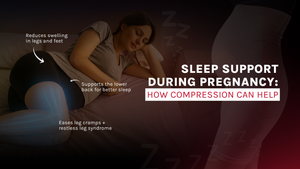Sleep Support During Pregnancy: How Compression Can Help
Pregnancy often brings about various physical changes that can disrupt sleep, including swelling, leg cramps, and discomfort. Incorporating compression garments into your routine may alleviate these issues, promoting better rest.
Understanding Pregnancy-Related Sleep Disruptions
During pregnancy, many individuals experience sleep disturbances due to factors like increased blood volume, hormonal changes, and physical discomfort. Common issues include:
-
Swelling (Edema): Fluid retention can cause swelling in the legs and feet, leading to discomfort.
-
Restless Leg Syndrome (RLS): An uncontrollable urge to move the legs, often disrupting sleep.
-
Leg Cramps: Sudden, painful muscle contractions, particularly at night.
These symptoms can significantly impact sleep quality during pregnancy.
How Compression Garments Aid Sleep
Compression garments apply gentle pressure to specific areas, promoting blood flow and reducing discomfort. Here's how they can help:
-
Reducing Swelling: By improving circulation, compression garments can decrease fluid buildup in the lower extremities, alleviating swelling.
-
Alleviating RLS and Leg Cramps: Enhanced blood flow may reduce the frequency and severity of restless leg syndrome and nocturnal leg cramps.
-
Providing Support: Compression garments can offer support to the abdomen and lower back, reducing strain and discomfort.
It's important to choose the appropriate level of compression and consult with a healthcare provider to ensure safety and effectiveness.
Safety Considerations
While compression garments can be beneficial, it's essential to use them correctly:
-
Proper Fit: Ensure the garment fits well without being too tight, which could impede circulation.
-
Duration of Wear: Consult with a healthcare provider regarding how long to wear compression garments, especially during sleep.
-
Medical Conditions: Individuals with certain medical conditions should seek medical advice before using compression therapy.
Conclusion
Incorporating compression garments into your pregnancy routine may alleviate discomforts that disrupt sleep, such as swelling and leg cramps. By promoting better circulation and providing support, these garments can contribute to improved sleep quality. Always consult with a healthcare provider to determine the best approach for your individual needs.
References
-
VIM & VIGR. (n.d.). Can You Sleep In Compression Socks When Pregnant? Retrieved from https://vimvigr.com/blogs/our-blog/sleep-in-compression-socks-when-pregnant(vimvigr.com)
-
ThedaCare. (n.d.). The Benefits of Compression Garments for Pregnant Women. Retrieved from https://homemedical.thedacare.org/blog/post/the-benefits-of-compression-garments-for-pregnant-women(homemedical.thedacare.org)
-
FitNest Mama. (n.d.). Compression garments for pregnancy and postpartum. Retrieved from https://www.fitnestmama.com/podcast/compression-garments-for-pregnancy-and-postpartum/(fitnestmama.com)
-
Verywell Family. (n.d.). How to Get the Most Out of Compression Socks During Pregnancy. Retrieved from https://www.verywellfamily.com/compression-socks-in-pregnancy-benefits-uses-tips-6735923(verywellfamily.com)

